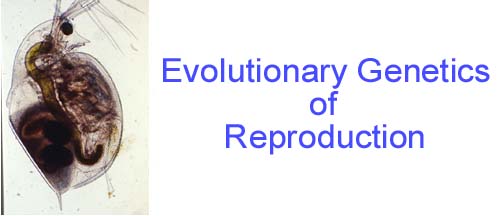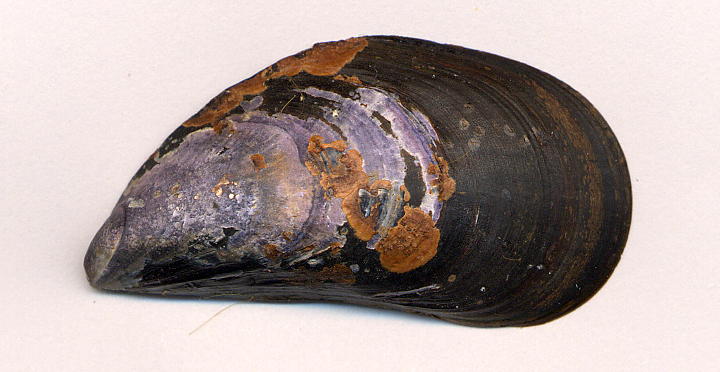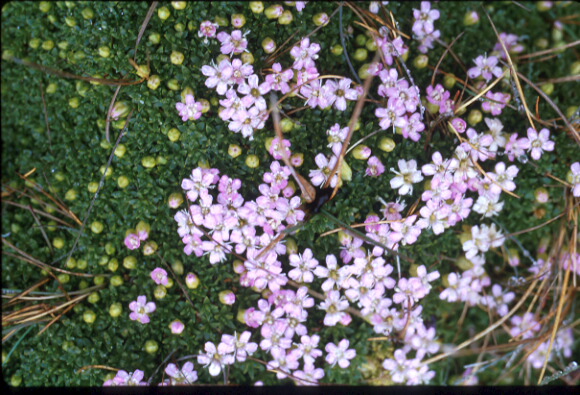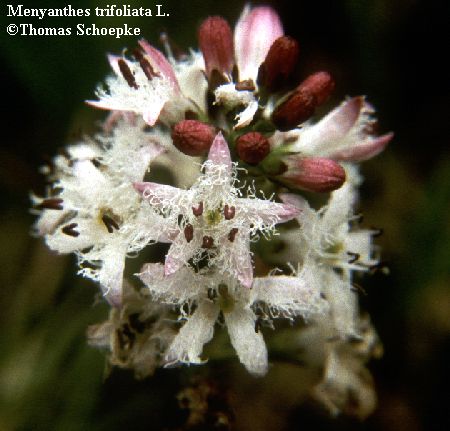
Bay
Bulls, Newfoundland Spring 2000 (D. Innes)
Dr. David J. Innes
Department of Biology
Memorial University of Newfoundland
St. John's, Newfoundland, A1B 3X9, Canada
Phone: (709) 864-4754 Fax: (709) 864-3018
email: dinnes"at"mun.ca (replace
at with @)
Research
The
research in my laboratory focuses on sexual and asexual reproduction, primarily
using the planktonic crustacean, Daphnia pulex
as a model organism (visit the Cladoceran Web Site at the University of Guelph). We
are also investigating the evolutionary genetics of the interaction between the
mussels Mytilus edulis,
M. trossulus and their hybrids in Newfoundland
(in collaboration with Dr. Ray Thompson, Ocean Sciences Centre). Collaborative
research has been carried out with Dr. Luise Hermanutz (Biology, MUN) on population and reproductive
ecology of moss campion (Silene
acaulis) and bog bean (Menyanthes
trifoliata) in Newfoundland, and the reproductive
ecology of Grevillea spp. in NSW Australia.
Research on the population structure and mating systems in Newfoundland spiders
has been conducted with Dr. Roger Pickavance.
A brief summary of current
research:
|
|
Evolutionary interaction between sexual and asexual Daphnia
pulex Daphnia
pulex
occurs as two forms, cyclical parthenogens with sexual reproduction and
obligate parthenogens with no sexual reproduction. Both forms co-occur in
southern Ontario but are rarely found in the same pond. We have been
determining sex allocation variation in the cyclical parthenogens and the
avoidance of the cost of males in the obligate parthenogens. Some obligate parthenogen clones can produce males that can mate with
sexual females from the cyclical parthenonogens and
generate new obligately parthenogenetic clones.
Current experiments are using microsatellite genetic markers to examine competition
among males for mating with sexual females and determine the evolutionary
dynamics of the formation of new obligately
parthenogenetic clones. |
|
|
Ecology and genetics of Mytilus spp.
in Newfoundland Two
species of mussel (Mytilus edulis, M. trossulus)
coexist along the coast of the island of Newfoundland. Limited hybridization
occurs between the species which may be due to incompatibility between
nuclear and cytoplasmic genes. In addition, we are
investigating the role gamete choice may play in limiting hybridization. For
additional information see: |
|
|
Genetic structure of moss campion (Silene acaulis) Silene acaulis occurs as disjunct populations on the island of Newfoundland.
Genetic differentiation appears to be high and the pattern is not related to
geographic distance separating the populations. Genetic differences
between populations on the east and west side of the island may be the
result of different colonization patterns following post glaciation
combined with random drift and limited gene flow. |
|
|
Reproductive ecology of Australian Grevillea
spp. Members
of the family Proteaceae have extremely low mature fruit : flower (FR : FL) ratios compared with other
temperate, hermaphroditic, woody perennials. The role of compatibility in
regulating FR : FL ratios was tested in five closely
related species of Grevillea (Proteaceae).
The correlation between self incompatibility and FR :
FL ratios was non-significant, indicating that compatibility has a minimal
effect on fruit set in the Grevillea species
studied. Low FR : FL ratios may result from a
combination of pollen limitation, and high levels of flower and fruit
predation. |
|
|
Reproductive ecology of Menyanthes
trifoliata in Newfoundland |
|
|
Genetic structure and mating behaviour in some Newfoundland
spiders
Three
species of native ground running spiders were compared with an introduced orb
weaving species for genetic differentiation over short and long geographic
distances. All species showed little evidence for genetic differentiation. It
is unlikely that gene flow is high in these species and it is possible that
large population size reduces the effect of genetic drift on population
differentiation. Studies are also examining the mating behaviour in the orb
weaver Araneus diadematus
to determine if multiple mating occurs. Preliminary data suggest that if
multiple mating occurs it is at a low level. |
|
Photo
Credits: Daphnia pulex (D. Innes); Mussel shell (D. Innes); Moss
Campion(L. Hermanutz); Grevillea
(Plant Systematics); Menyanthes
(T. Schoepke); Spider (Spider Web Page) |
Teaching
Biology 2900 Principles of Evolution and Systematics
Biology 4250 Evolutionary Genetics
Biology 7290 Evolutionary Ecology
Students
Graduate
Students
- Shin Kim (Ph.D. in
progress) Genetic structure and population connectivity of a mussel
hybrid zone
·
Kan
Miao (M. Sc. in progress) Genetic
structure of sexual and asexual Daphnia
pulex
- Guangxu Liu (Ph.D. 2009) Genetic barriers to introgression in a mussel hybrid zone
- Ben
Lowen (Ph. D. in 2008) Life history
variation in a mussel hybrid zone
- Marcelo Miranda (Ph.D. 2005) Genetics of
hybridization in a mussel hybrid zone
- James Fitzsimmons (M. Sc. 2006) Sex and evolution
in Daphnia pulex
- Jorge Toro (Ph.D. 1999) Natural hybridization in
mussels
- Barbara Saunders (M. Sc.
1998) Inheritance and linkage of RAPD markers in Daphnia
- Jennifer Bates (M. Sc.
1991) Morphological and genetical variation of Mytilus edulis
in Newfoundland
Undergraduate
Thesis Students
- Erin Stapleton 2006 Interactions between Mytilus edulis
and M. trossulus spat
- Michael Ginn 2005 Competition
between cyclically and obligately
parthenogenetic Daphnia pulex
- Dax Rumsey 2002 Male
production in the obligately parthenogeneic
Cladoceran Daphnia pulex
- Trina Kirby 2002 Mating system in the spider Araneus diadematus
- Kerri Anstey 1999
Genetic variability and gene flow in five species of spiders found in
Newfoundland (Pardosa hyperborea,
Pardos moesta, Pardosa groenlandica,
Cyclosa conica,
& Araneus diadematus)
determined using allozyme electrophoresis
- Chris Fox 1998
Differences in ephippial production between
obligate and cyclical parthenogenetic clones of Daphnia pulex
- Geoff Winsor 1997 Sexual reproduction in Daphnia
pulex: Observations on mating behaviour and avoidance of intra-clonal mating
- Barbara Saunders 1995 RAPD genetic variation among
populations of Daphnia pulex
Publications:
On Daphnia:
Crease T.J., Floyd R., Cristescu M.E., Innes
D.J. (2011) Evolutionary factors affecting Lactate dehydrogenase
A and B variation in the Daphnia pulex
species complex. BMC Evolutionary Biology 11:212 http://www.biomedcentral.com/1471-2148/11/212
Cristescu M.E., Innes D.J., Stillman
J.H., Crease T.J. (2008) D- and L-lactate dehydrogenases
during invertebrate evolution. BMC Evolutionary Biology, 8: 268. http://www.biomedcentral.com/1471-2148/8/268
Fitzsimmons, J. M. and Innes, D. J. (2006) Inter-genotype variation in reproductive response to crowding among Daphnia pulex. Hydrobiologia 568:187-205 (download PDF file)
Tagg, N., Doncaster, C.P. and Innes, D. J. (2005) Outcomes of reciprocal invasions between genetically diverse and genetically uniform populations of Daphnia obtusa (Kurz). Oecologia 143: 527-536(download PDF file)
Fitzsimmons, J. M. and Innes, D. J. (2005) No evidence of Wolbachia among Great Lakes area populations of Daphnia pulex (Crustacea: Cladocera). Journal of Plankton Research 27:121-124 (download PDF file)
Tagg, N., Doncaster, C. P. and Innes, D. J. (2005) Resource competition between genetically varied and genetically uniform populations of Daphnia pulex (Leydig): does sexual reproduction confer a short-term ecological advantage? Biol. J. Linn. Soc. 85: 111-123 (download PDF file)
Winsor, G. L. and Innes, D. J. (2002) Sexual reproduction in Daphnia pulex (Crustacea: Cladocera): Observations on male mating behaviour and avoidance of inbreeding. Freshwater Biology 47: 441-450(download PDF file)
Innes, D. J. and Singleton, D. R. (2000) Variation in allocation to sexual and asexual reproduction among clones of cyclically parthenogenetic Daphnia pulex (Crustacea: Cladocera). Biol. J. Linn. Soc. 71(4): 771-787 (download PDF file)
Innes, D. J., Fox, C. J. and Winsor, G. L. (2000) Avoiding the cost of males in obligately asexual Daphnia pulex (Leydig). Proc. Roy. Soc. B 267: 991-997 (download PDF file)
Innes, D. J. (1997) Sexual reproduction of Daphnia pulex in a temporary habitat. Oecologia 111, 53-60. (download PDF file)
Innes, D. J. and Singleton, D. R. (1994) Variation in reproduction and sex allocation among clones of Daphnia pulex, In Genetics and Evolution of Aquatic Organisms (ed. A. R. Beaumont), pp. 335-342. London: Chapman and Hall.
Innes, D. J. and Dunbrack, R. L. (1993) Sex allocation variation in Daphnia pulex. J. evol. Biol. 6, 559-575.
Innes, D. J. (1991) Geographic patterns of genetic differentiation among sexual populations of Daphnia pulex. Can. J. Zool. 69, 995-1003.
Innes, D. J. (1989) Genetics of Daphnia
obtusa: Genetic load and linkage analysis in a
cyclical parthenogen. Journal of Heredity 80: 6-10.
Innes, D. J. and P. D. N. Hebert. (1988) The origin and
genetic basis of obligate parthenogenesis in Daphnia pulex. Evolution 42:1024-1035.
Innes, D. J., S. S. Schwartz and P. D. N. Hebert 1986. Genotypic diversity and variation
in mode of reproduction among populations in the Daphnia pulex group. Heredity 57:345-355.
Schwartz, S. S., D. J. Innes and P. D. N. Hebert (1985) Morphological
separation of Daphnia pulex and Daphnia obtusa
in North America. Limnology Oceanography 30: 189-197.
On Bivalves:
Liu G.X., Stapleton E., Innes D.J., Thompson, R.J. (2011) Aggregational behavior of the blue mussels Mytilus edulis and Mytilus trossulus: a
potential pre-zygotic reproductive isolation mechanism. Marine Ecology 32: 480-487. http://onlinelibrary.wiley.com/doi/10.1111/j.1439-0485.2011.00446.x/abstract
Liu G.X., Innes D.J., Thompson R.J. (2011)
Quantitative analysis of sperm plane circular movement in the blue mussels Mytilus edulis, M. trossulus
and their hybrids. Journal of Experimental Zoology PART A-
Ecological Genetics and Physiology, 315A (5): 280-290. http://onlinelibrary.wiley.com/doi/10.1002/jez.674/abstract
Miranda M.B.B., Innes D.J., Thompson R.J. (2010) Incomplete reproductive isolation in the blue mussel (Mytilus edulis and M. trossulus)
hybrid zone in the Northwest Atlantic: Role of gamete interactions and larval
viability. Biological Bulletin, 218,
266-281. http://www.biolbull.org/content/218/3/266.full?sid=b06a9774-8172-42fd-a4bd-b3c2e795d4d8
Toro, J. E., R. J. Thompson
and D. J. INNES (2006) Fertilization success and early survival in pure and
hybrid larvae of Mytilus edulis
(Linnaeus, 1758) and M. trossulus (Gould, 1850) from laboratory crosses. Aquaculture Research 37: 1703-1708
Toro, J. E., D. J. INNES and R. J. Thompson (2004) Genetic variation among life-history stages of mussels in a Mytilus edulis –M. trossulus hybrid zone. Marine Biology 145, 713-725. (download PDF file)
Toro, J. E., R. J. Thompson and D. J. INNES (2002) Reproductive isolation between coexisting mussel species (Mytilus edulis, M. trossulus) in Newfoundland. Marine Biology 141, 897–909. (download PDF file)
Comesańna, A. S., Toro, J. E., Innes, D. J. and Thompson, R. J. (1999) A molecular approach to the ecology of a mussel (Mytilus edulis - M. trossulus) hybrid zone on the east coast of Newfoundland, Canada. Marine Biology 133, 213-221. (download PDF file)
Innes, D. J. and Bates, J. A. (1999) Morphological variation of Mytilus edulis and Mytilus trossulus in eastern Newfoundland. Marine Biology 133, 691-699. (download PDF file)
Jones, R., Bates, J. A., Innes, D. J. and Thompson, R. J. (1996) A quantitative genetic analysis of growth in larval scallops (Placopecten magellanicus). Marine Biology 124, 417-424.
Bates, J. A. and Innes, D. J. (1995) Genetic variation among populations of Mytilus spp. in eastern Newfoundland. Marine Biology 124, 417-424.
Muncaster,
B. W., D. J. Innes, P. D. N. Hebert and G. D. Haffner
(1989) Patterns of organic contaminant accumulation by freshwater mussels in
the St. Clair River, Ontario. J. Great Lakes. Res. 15: 645-653.
Koehn, R. K., J. G. Hall, D. J. Innes and A. J. Zera
(1984) Genetic differentiation of Mytilus edulis in eastern North America. Mar. Biol. 79: 117-126.
Innes, D. J. and L. E. Haley (1977)a.
Inheritance of a shell color polymorphism in the mussel. J. of Heredity 68:
203-204. http://jhered.oxfordjournals.org/content/68/3/203.full.pdf+html
Innes, D. J. and L. E. Haley (1977)b. Genetic
aspects of larval growth under reduced salinity in Mytilus edulis. Biol. Bull. 153: 312-321. http://www.biolbull.org/content/153/2/312.full.pdf+html?sid=b06a9774-8172-42fd-a4bd-b3c2e795d4d8
On plant mating systems and
population genetics:
Thompson, F. L., Hermanutz, L. A. and Innes, D. J. (1999) The reproductive ecology of island populations of distylous Menyanthes trifoliata (menyanthaceae). Can. J. Bot. 76, 818-828. (download PDF file)
Hermanutz, L. A., Innes, D. J., Denham, A. and Whelan, R. (1998) Very low fruit: flower ratios in Grevillea (Proteaceae) are independent of breeding system. Australian J. of Botany 46, 465-478. (download PDF file)
Rajora, O. P., Deverno, L., Mosseler, A. and Innes, D. J. (1998) Genetic diversity and population structure of disjunct Newfoundland and central Ontario populations of eastern white pine (Pinus strobus). Can. J. Bot. 76, 500-508. (download PDF file)
Hermanutz, L. A. and Innes, D. J. (1994)
Gender variation in Silene acaulis (Caryophyllaceae). Plant Sytematics and Evolution 191, 69-81.
Mosseler, A., D. J. Innes and B. A. Roberts. (1991) Lack of allozymic
variation in disjunct Newfoundland populations of red
pine (Pinus resinosa).
Can. J. For. Res. 21: 525-528.
Innes, D. J. (1990) Microgeographic genetic
structure in the haploid and diploid stages of the moss Polytrichum juniperinum Hedw.
Heredity 64: 331-340.
Innes, D. J. and G. S. Ringius
(1990) Mating system and genetic structure of two populations of white spruce (Picea glauca) in
eastern Newfoundland. Can. J. Bot.
68: 1661-1666.
Ringius, G. S. and D. J. Innes. (1990) Large disparity in
recombination fractions reported in Picea mariana for the Aat-1/Pgi-2 linkage group. Can. J. Bot.
68: 518-520.
Hermanutz, L. A., D. J. Innes and I. M. Weis. (1989) Clonal
structure of dwarf birch, Betula glandulosa, at its northern limit. Amer. J. Bot.
76: 755-761.
Innes, D. J. and L. A. Hermanutz
(1988) Mating system and genetic structure in a disjunct
population of the seaside goldenrod, Solidago sempervirens.
Heredity 61: 447-454.
Innes, D. J. (1988) Genetic differentiation in the
intertidal zone for the alga Enteromorpha linza (Ulvales, Chlorophyta).
Mar. Bio. 97:9-16.
Innes, D. J. (1987) The genetic structure of
asexually reproducing Enteromorph linza (Ulvales, Chlorophyta) in Long
Island Sound. Marine Biology 94:459-467.
Innes, D. J. (1984) Genetic differentiation among
populations of marine algae. Helgolander Meersuntersuchungen
38: 401-417.
Innes, D. J. and C. Yarish (1984)
Genetic evidence for the occurrence of asexual reproduction in populations of Enteromorpha linza (L.)J. Ag. (Chlorophyta,
Ulvales) from Long Island sound. Phycologia 23: 311-320.
Other publications
Zera, A.
J., D. J. Innes and M. E. Saks (1983) Genetic and environmental determinants of
wing polymorphisms in the waterstrider Limnoporus canaliculatus.
Evolution 37: 513-522.
Smith, G. R., J. G. Hall, R. K. Koehn and D. J. Innes (1983) Taxonomic
relationships of the Zuni mountain sucker, Catostomus discobolus yarrowi. Copeia 1983: 37-48.




